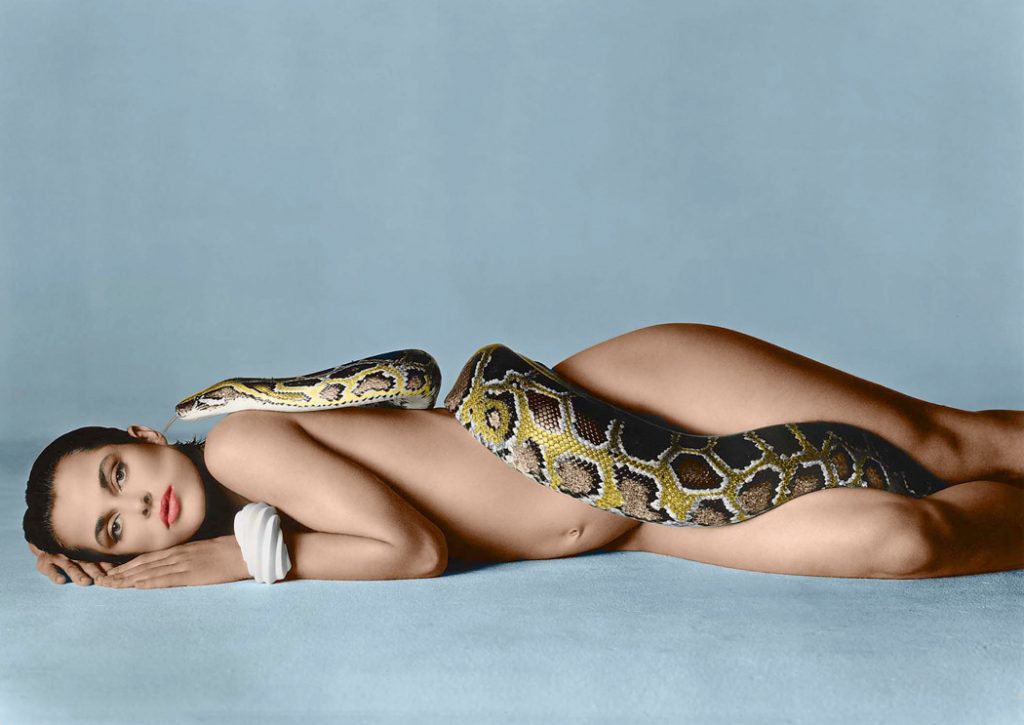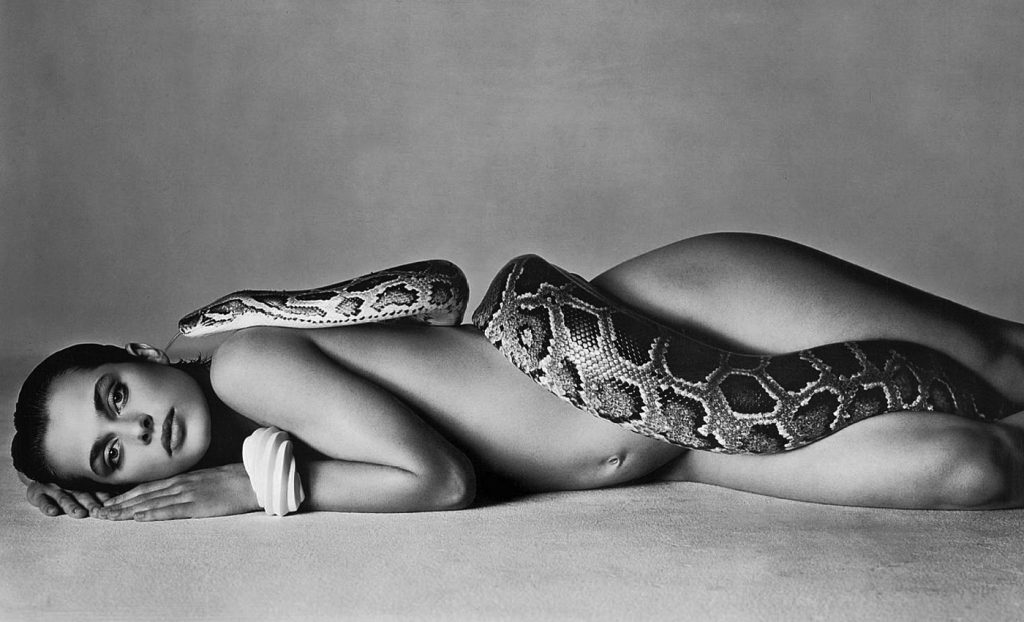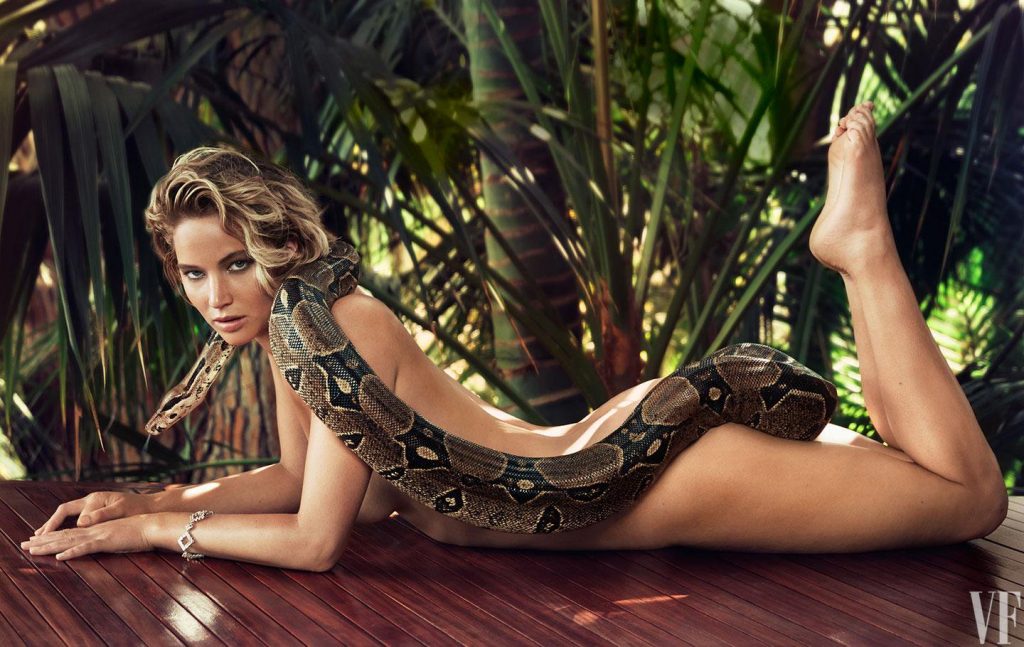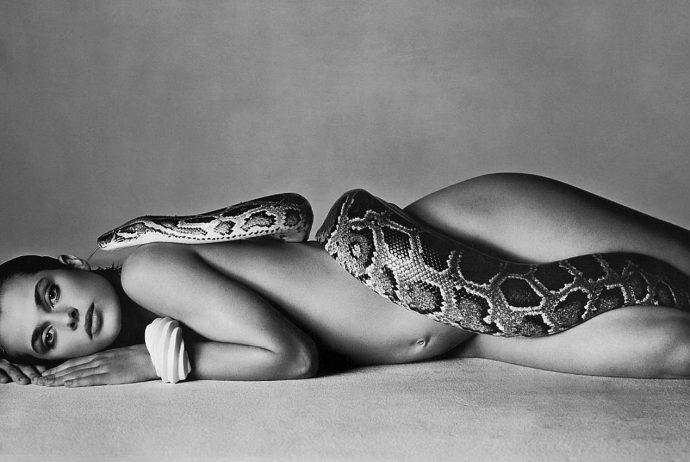“She rose to the occasion. The snake rose to the occasion. I rose to the occasion.”
— Richard Avedon
There is no more iconic image of Nastassja Kinski than the portrait of her, naked – save for a Patricia von Musulin bracelet – with a Burmese python decorously wrapped across her, its tongue flicking into Kinski’s ear. The photograph was taken by renowned photographer Richard Avedon on June 14, 1981, in a shoot for Vogue magazine, and became one of the best-selling posters of the decade. It subsequently inspired a host of other women to adopt similar poses, including Nastassja’s daughter, Sonia, and in a 2014 shoot for Vanity Fair, Jennifer Lawrence. But nor was its imagery created out of nowhere. Let’s look at what came before, as well as the act of its creation, and those which followed in its wake.
The origins of the archetype
Intertwined with a boa constrictor, grappling with temptation, seduction and power, Kinski is clearly referencing deeply rooted concepts in classical art and mythology.
— Sotheby’s catalogue, February 2018.
Women and snakes have been connected for, literally, thousands of years. The most obvious link is the story of Adam and Eve in the Garden of Eden, where Satan, in the form of a serpent, convinced Eve to pick forbidden fruit from the tree of knowledge. But Christian mythology is certainly not the origin of the archetype. As with much of Christianity, this story may have been a more or less conscious co-opting of pre-existing traditions, turning one of the numerous pagan snake deities, such as the Sumerian Nirah, into the villain of the piece.
Tales of women and snakes span the globe and the centuries, often depicted in a more positive light than by Judeo-Christian lore. The indigenous Pomo tribe of California have a legend telling of a woman who married a rattlesnake-prince, and gave birth to four snake-children. Or in Africa, we find water deity Mami Wata, about whom Wikipedia says, “A large snake frequently accompanies her, wrapping itself around her and laying its head between her breasts.” Perhaps the most iconic of mythological reptile/female combinations is Medusa, a woman with living snakes for hair – and much like Nastassja in the photo, her gaze could turn a man to stone.
It’s perhaps worth quoting at some length what Plutarch wrote about Alexander the Great’s parents, Olympias and Philip, around the beginning of the second century AD: “Once, moreover, a serpent was found lying by Olympias as she slept, which more than anything else, it is said, abated Philip’s passion for her.” He goes on to state Olympias was a member of a snake cult and, “was wont in the dances proper to these ceremonies to have great tame serpents about her, which sometimes creeping out of the ivy in the mystic fans, sometimes winding themselves about the sacred spears, and the women’s chaplets, made a spectacle which men could not look upon without terror.”
As far as Christian mythology is concerned, there’s an argument Kinski is less playing Eve than Lilith, a character first mentioned in Babylonian saga, The Epic of Gilgamesh, which dates back to 2400 BC. While only briefly mentioned in the “official” Bible, other religious works name her as Adam’s first wife. The Zohar, the main text of the Kabbalah, associates Lilith with Samael, King of the Demons, and says [emphasis added], “The female of Samael is called ‘snake,’ ‘a wife of harlotry,’ ‘the end of all flesh,’ ‘the end of days.'” As a result, many depictions from the Middle Ages, portray the snake with Lilith’s face, including Michelangelo’s Temptation and Fall in the Sistine Chapel. In recent times, Lilith has been reclaimed by feminists as a symbol of independence from the dominion of men and sexual freedom. Quite the journey for a five thousand year old, Babylonian she-demon.
In terms of artistic depictions, the other main item combining women and snakes is probably the death of Cleopatra – or as it was once called, “the greatest asp disaster in the world”… However, size does matter when it comes to snakes, and the fun-sized reptiles with which she is shown, appear to be from a different sub-genre. We should also mention in passing the extremely obvious Freudian symbolism. Creative director Polly Mellen, who was helping Avedon out that day, says, “When she held it, there was something really sensual about the snake. I don’t want to be vulgar, but… it reminded me of something else.”
Such elements are particularly apparent in Gustave Flaubert’s novel, Salammbo, about a Carthaginian priestess. For your consideration: “The python turned downwards, and resting the centre of its body upon the nape of her neck, allowed its head and tail to hang like a broken necklace with both ends trailing to the ground. Salammbo rolled it around her sides, under her arms and between her knees; then taking it by the jaw she brought the little triangular mouth to the edge of her teeth, and half shutting her eyes, threw herself back beneath the rays of the moon… Salammbo panted beneath the excessive weight, her loins yielded, she felt herself dying, and with the tip of its tail the serpent gently beat her thigh.”
Which seems like a good point to move on, pausing only to mop our brows.
The shoot
He was probably the only person who could have told me to take my clothes off and lie on the floor with a snake—and I’d do it.
— Nastassja Kinski
There seems to be some doubt as to who came up with the idea of using a snake for the picture. Kinski recalls it being Avedon’s idea: “We were in the studio with designer clothes and makeup and jewelry. But he suddenly said, ‘This is not happening for me.’ He made a few phone calls, and before you know it we had a snake in the studio.” Mellen remembers things differently. While she agrees with Nastassja that the session started as a normal fashion shoot, she remembers asking the model, “Do you have any special things that you like?” to which Kinski replied, “I like snakes.”

A reptile was duly procured, and Avedon then asked Kinski if she was willing to be photographed in the nude. She agreed – but getting her co-subject to comply proved to be quite another matter. According to the photographer, “It all looks so easy. She spent two hours on a cement floor, naked. The trainer would start anchoring the snake with her ankles, and then see where the snake would go. Hope that the snake — because there’s no talking to a snake — would creep up Nastassja in a way that was beautiful… It was really fashion hell.”
But finally the miracle happened, as the snake wound its way up unto her shoulder. Avedon says, “It was one of those absolutely magical things that happens, which nothing you plan could equal… I said, ‘Nastassja, this is it. Quickly, relax!'” Mellen was dumbstruck by the moment: “You couldn’t imagine being there. I mean, the snake kissed her! The snake wound up her little naked body and put its tongue in her ear, and the picture was done. I couldn’t believe what I was seeing.” However, Mellen later said she regretted the presence of the bracelet: “It became a fashion statement, and I thought the picture was something else.”

She also says, “The snake had been defanged, so there was no worry on that stance.” While she may know a great deal about fashion, she apparently doesn’t know much about snakes. For the Burmese python is non-venomous and kills its prey by constriction, wrapping its powerful body around them, and squeezing so that are unable to breathe. Its fangs are not the “worry” here. What probably does concern me though, is the number of sources who report to this day that Kinski was pregnant during the shoot. Looking at her belly, that seems plausible: except there’s a problem. Her first child, Ayosha, wasn’t born until July 1984, more than three years later. No explanation for this is comforting.
Even the title of the piece is thoughtful, deliberately using “serpent”, perhaps to evoke the Biblical images. It’s not an insignificant difference. One lexicographer observed that “snakes are insidious, cold and contemptible, while serpents are terrible, powerful, and beautiful.” While it hatched a million posters – actually two million, by one estimate – if you want one of the original prints, whose run was limited to only a couple of hundred, you’ll have to save up a bit more money. In a February 2018 auction at Sotheby’s, #52 was sold for £62,500.
The clones
Watch her take the pleasures from the serpent, that once corrupted man…
— Blade Runner
We’ve established that Avedon and Kinski were certainly not the first to create art combining women and snakes, and equally certainly, they were not the last. However, their collaboration changed the landscape forever, with every subsequent such piece apparently taking influence from them. It’s similar to how movies had included scenes in showers before Alfred Hitchcock went there for Psycho But after he did, nothing was the same: to this day, if someone picks up a kitchen implement to use as a weapon, odds are that it’ll be what has become known as “the Psycho knife.” Nastassja and the Snake had a similar impact in the world of fashion photography.
And the apple doesn’t fall far from the tree, it appears – even if the fruit comes from the tree of forbidden knowledge. For Nastassja’s daughter Sonja has already embraced her mother’s fondness for snakes, on not one, but two separate occasions. In the 400th edition of Photo magazine in June 2003, Sonja posed with an albino Burmese python for Michele Comte. And eight years later, she played Eve in a 2011 advert for Pom Wonderful, certainly evoking the image of her mother’s iconic photo,three decades previously. Adding to the Kinski connection, the commercial narration is by Malcolm McDowell, who appeared alongside Nastassja in Cat People.
The sheer range of imitations is startling, even if we restrict ourselves fairly narrowly, to images specifically depicting a model lying naked on the ground, with the snake on top of her. [And that’s just the tip of a very large reptilian iceberg!] There are photographs involving women, men, puppets, animated characters and even Legos. Some of them put their own spin on the concept in one way or another. Others are shamelessly derivative, right down to the bracelet: perhaps that’s simply a metaphor for the Ouroboros which is the fashion industry, forever eating itself.
The most recent of note saw Oscar winner Jennifer Lawrence pose with a Colombian red-tailed boa constrictor, in a shoot for Vanity Fair by photographer Patrick Demarchelier. Per reports, “Lawrence only became uncomfortable when the snake took a fancy to her neck.” [Are you listening, Polly Mellen?] At least this was an open Avedon homage, though not everyone was impressed. One writer criticized Lawrence’s “dead-eyed pout… look again at that Avedon portrait of Nastassja Kinski. Look at how grounded she looks, how serene by comparison. Though equally naked, she seems less exposed somehow.” Shot in July 2014, Lawrence’s pic wasn’t released until February the following year – perhaps due to the subsequent leak of her iCloud photos. It still promptly broke the Internet.

After having spent more time than I care to consider trawling various depths of the web, part of me has to wonder if the style has perhaps gone beyond iconic to cliched. However, such is likely the fate of all high art which achieves a place in popular consciousness, and all the subsequent copies, knock-offs and homages do absolutely nothing to detract from the qualities of the original. It remains iconic and much-imitated for good reason, an exemplary case in what happens when artistry and good fortune come together for a fleeting moment. The results are near perfection, and I would argue, Nastassja and the Serpent deserves to be ranked among the great art pieces of the twentieth century.
Sources
I want to mention some places on the web which were of particular help in writing this piece, both for information and images.
- Richard Nilsen’s series of articles, Lady and the Snakes
- The Vestustideces article: El icono Kinski-Avedon: yaciendo con serpientes (The Kinski-Avedon icon: lying with snakes)
- Two sites, one Russian and the other Japanese, were also particularly image-friendly.





































